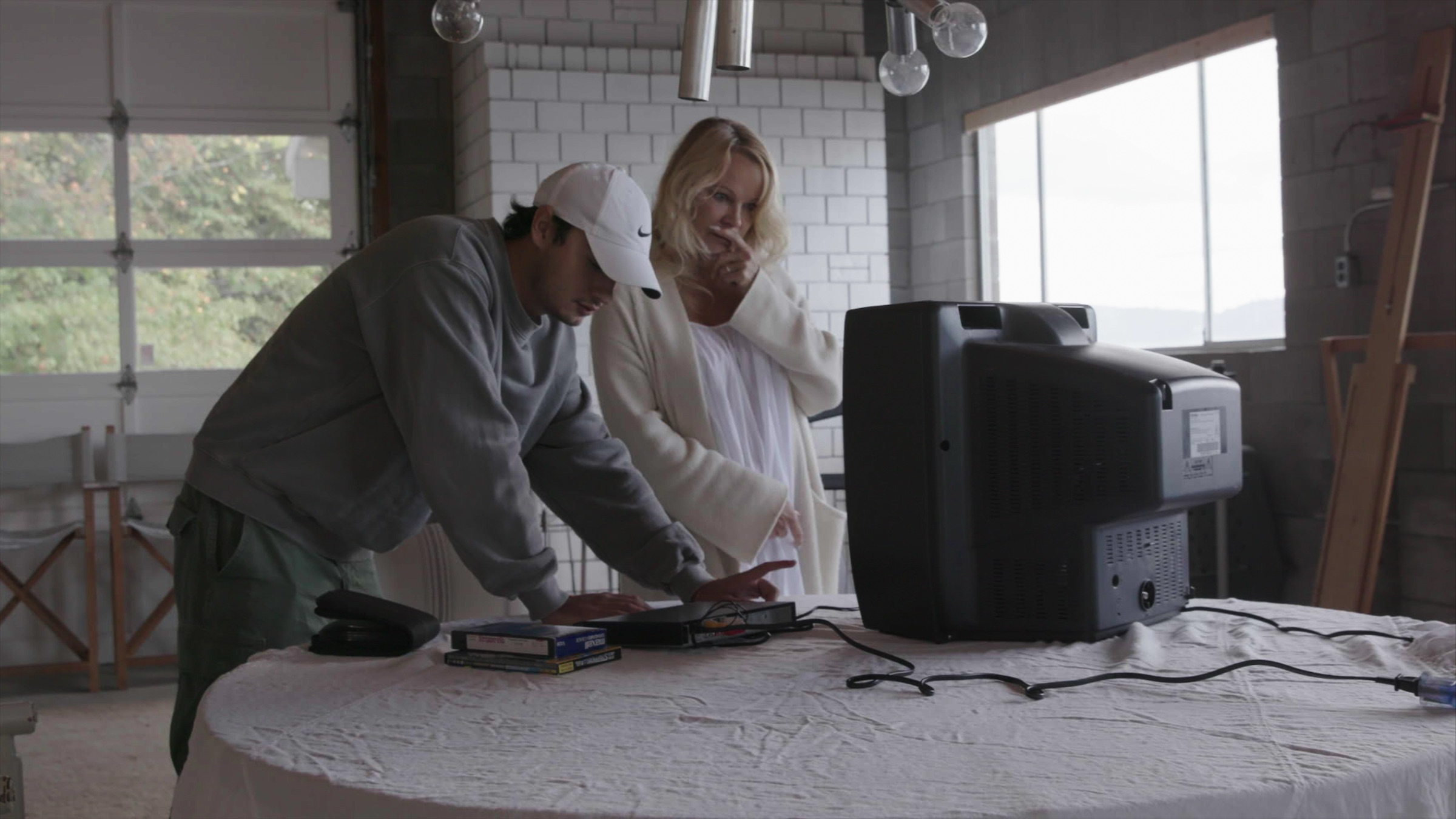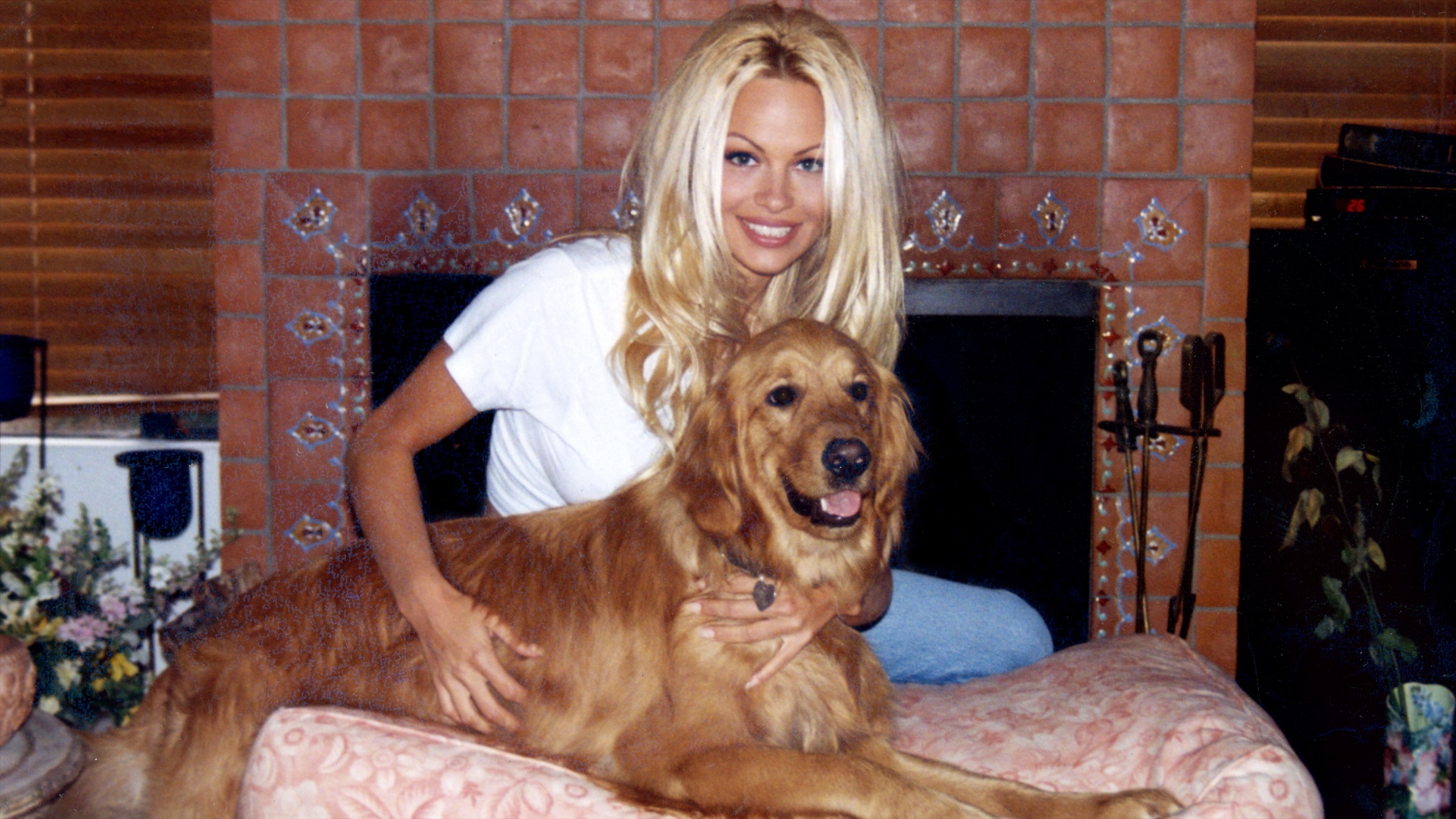In Pamela, a Love Story, the flashing lights of the paparazzi and lurid tabloid headlines that marked Pamela Anderson’s life during the early aughts are far removed from the quiet life she’s made for herself now, after retreating to her grandmother’s boathouse on the small island town of Ladysmith, British Columbia, where she grew up.
Helmed by director Ryan White and co-produced by one of Anderson’s sons, Brandon Lee, the film is a surprisingly gentle meditation on Anderson’s extraordinary life, going from her turbulent childhood, during which she suffered multiple abuses, to her discovery at a Canadian football game, to the dizzyingly meteoric fame that came after she became a Playboy model and television star via Baywatch in the 1990s and early 2000s. Her career and romantic relationships provide rich fodder for a modern fairy tale, a “Cinderella story on steroids,” as White refers to it. Anderson’s life appears to reach its apex once she falls in love with, marries, and starts a family with musician Tommy Lee, but that image is shattered once a stolen intimate home video of the couple becomes the Internet’s first viral moment.
While the film addresses the gross sexism and misogyny that cause upheaval Anderson’s life and career in the wake of the notorious tape, it’s less concerned with the pain of the past than it is the life that Anderson has built since, showcasing her resilience and the way she has leaned into being a mother, an activist, and a free-spirited artist—defining herself outside of the narratives foisted on her by the public.
Read More: Hulu’s Abysmal Pam & Tommy Is at Its Worst When Paying Lip Service to Feminism
White had not anticipated directing a documentary about Pamela Anderson; in his career he has shied away from covering celebrities, but he changed his mind after a Zoom meeting with Lee, who urged him to take a call with Anderson.
“I was born in 1981 and I had this image of Pamela in my head as the most famous person in the world to me when I’m coming of age,” White tells TIME. “She was like my Kardashian, my Marilyn Monroe. We had a two or three hour conversation and everything about her surprised me. That’s what I’m hoping for as this film comes out, that people will be really surprised about who the real Pamela Anderson is.”
Lee’s tells TIME his hope for the film is similar: “The real message here is that there is a real person underneath all of those experiences.”
The film draws on Pamela Anderson’s huge personal archive
White had a wealth of material to draw on for the film, thanks to Anderson’s faithful self-documentation. Throughout her adult life, Anderson has kept a journal, writing about everything from her career goals to her romantic relationships and family life; in one particularly bittersweet scene in the documentary, she writes a letter to her then-one-year-old son Dylan, following the incarceration of her then-estranged husband Tommy Lee. In addition to her journals are an archive of VHS tapes that document everything from home life with her sons and their childhood birthday parties to vacations with ex-husband Tommy Lee. For Brandon Lee, Anderson’s documentation comes from a very personal place.
“I think through the years after going through so much, she’s clung to a lot of her personal treasures and guarded them over the years,” he says. “They’re kind of her evidence to herself that over the years she had a wonderful family and a lot of fantastic moments.”

Brandon Thomas Lee and Pamela Anderson in 'Pamela, a love story'
Courtesy of Netflix
For years, Anderson stored the journals and tapes in a loft in the boathouse, not revisiting them until she offered all of the archive, without reviewing it, to White for the documentary, allowing him to not only use the archive for research but to use the material in the film. Upon being given access to the archive, White flew up to Ladysmith, where he filmed Anderson diving back into the old journals and tapes for the first time in years and later, in some of the sweetest moments of the film, reviewing home videos with her sons on a VCR and monitor that White got from a local pawn shop.
The extensive materials become the thruline of the film, showing the growth and evolution of Anderson throughout the years, from her childhood to present day. As such, handling the archive became one of the most crucial and important elements of the film’s production. When White began doing the research for the film back in Los Angeles after the first trip to Ladysmith, he tasked Lee with carrying the first shipment of tapes back to L.A. via a carry-on that couldn’t be put through the airport’s X-Ray machine, having each tape checked individually. Later, White actually drove a cargo van with much of the archive from Ladysmith to Los Angeles over the course of five days, lest he risk losing any of the archive by sending it via mail.
Anderson was hands-off when it came to her portrayal
The ethics of documentary filmmaking—especially when a subject or those close to a subject are involved, like Anderson’s son Brandon being a producer—can be tricky, but White found that while Anderson was an enthusiastic collaborator as a subject, she had zero interest in trying to control the edit or direction of the film, something he found refreshing, especially for someone with her level of fame, who might be concerned with how they were presented to the public.
“She’s very collaborative from an emotional level and an artistic level, but when it came to the filmmaking and editing conversation, she was very detached from the process, which appealed to me as a storyteller,” White said. “I thought, this is rare. Why is she not asking all of these really enterprising questions you would typically get out of someone?”
Read More: How Docu-Mania Took Streaming by Storm
White said Anderson’s openness to working with him and sharing the most vulnerable parts of her life with him as a key part of the trust he was able to exercise while making the film, pointing to her offering him her diaries and videos and allowing him to use what he wanted without consulting her first as one of the most outsize examples of this, as well as a particularly raw scene where she allows him to interview her in the bathtub while she reflects on the pain of being unable to make her marriage work with the father of her children, something that her son says he believes she was processing for the first time while on camera.
“This woman is, shockingly, for her stature of fame and celebrity, so vulnerable in the way she’s willing to work, to open up,” White said.
Lee said that his mother’s hands-off approach when it came to the film was a part of her respect for White’s craft as a filmmaker, seeing it as her way of being a true collaborator, modeling the behavior she hoped people would do for her when she was in the driver’s seat.
“If we’re at a photo shoot, she wants to be the subject, she knows she’s the art,” Lee says. “She does not want to step on the artist’s toes ever because she knows what that feels like. She definitely knows that from the process of writing her book; if someone stepped on her toes, it was a disaster, it was her process.”

Pamela Anderson in 'Pamela, a love story'
Courtesy of Netflix
The goal of the documentary was not to correct the narrative
Toward the end of the documentary, Anderson’s world is upended once again when the Hulu series Pam & Tommy is set to release. White stresses that the documentary is in no way a response to the series; according to him, they began working on the documentary before they even knew that the series existed. For Anderson, who has not seen the series and has no plan to, the goal behind making the documentary was not to correct the narrative, but to tell her story authentically.
“From the beginning, both Pamela and I have said that this has nothing to do with taking the narrative back from that show—she never liked that type of messaging,” White says. “With her memoir and this film coming out, it is her getting to take her narrative into her own hands, but that was never her goal—they’re both artistic expressions that tell her story authentically, but she’s not trying to course correct how anyone else has told it.”
Write to Cady Lang at [email protected].


